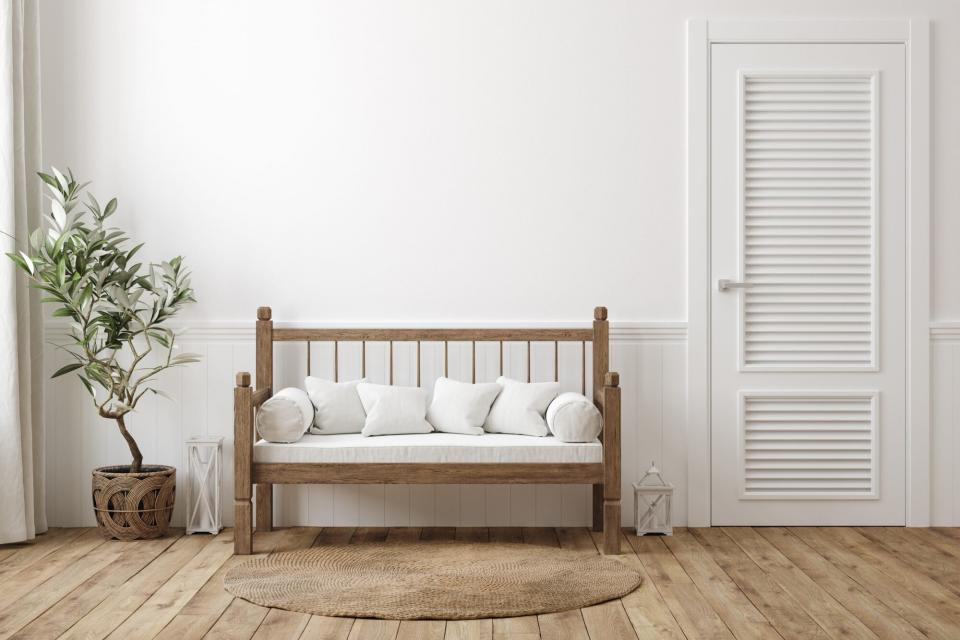What Is Scandinavian Design? We Asked 2 Experts Why This Style Continues to Stand the Test of Time

GETTY IMAGES
TABLE OF CONTENTS
On This Page
History
Future
How to Bring Scandinavian Design to Your Home
Since its inception, Scandinavian design has managed to strike an impeccable balance of raw nature, hygge comfort, and striking minimalism. In other words, it takes the best of various design approaches and bundles them into one satisfying, perfect—but not too perfect—package. Think clean leans, white walls, and blonde wood paired with natural light, rumpled blankets, flickering fires, and earth tones complemented by the occasional pop of color. It offers handsomeness and serenity, but also a sense of whimsy that just makes you feel good.
"The root of Scandinavian design philosophy stems from timeless and intentional design," says Teresa Olson, a Milwaukee-based interior designer with a strong Scandinavian heritage. "It's a nod to nature, a celebration of design integrity, and an homage to the planet and sustainability."
All the above is precisely why Scandinavian design has had decades-long staying power, and why it's an aesthetic that's here to stay. Let's take a closer look at how Scandi style has evolved over the years, ways we might see it change yet, and how to incorporate Scandinavian design elements into your own space.
Related: This Revamped Farmhouse Was Inspired by 1800s New England and 20th-Century Scandinavia
A History of Scandinavian Design
Scandinavia is greatly influenced by its own chilly climate, local resources, and surrounding natural beauty. Geographically isolated by the Roman empire, Nordic countries also established their own design language—an aesthetic referred to as Urnes style—which dates back to the Viking era. This style is deeply rooted in nature and serves as a celebration of sorts to the Norse Gods.
Folk Art
"The Scandinavian design of my great-grandparents, and even grandparents, would fall much more in the realm of what would be today considered folk art—like floral rosemaling and other traditional patterns, rag rugs, and such," says Olson. "Then, in the mid-century era, advances in technology and production created the ability to design sleeker and cleaner-lined furniture, home décor, and buildings."
Mid-Century Movement
These new-age designs really started coming into fashion in the 1930s, where they skyrocketed to fame and eventually became pillars of the mid-century modern style. "Take the Urnes vernacular and mix in the modern aesthetic movement, and by the time we hit the 1950s, Scandinavian design had struck the very appealing balance we know today: a mix of elegant and natural with modern minimalism," says Julie Brayton, principal and lead designer of Brayton Interiors.
Brayton adds that when we look back at the furniture shapes developed and made popular by Scandinavian designers in the mid-century era, you'll still see a glimmer of that Urnes style; the carvings in Hans Wegner's Elbow or Wishbone chairs are perfect examples of this.
Accessibility
In addition to its overall appeal, what really helped cement Scandinavian design across the world—both then and through today—was its accessibility. Designers in these countries have a democratic mindset, notes Bryton, and purposefully make their beautiful furniture accessible to all.

CreativaStudio / GETTY IMAGES
The Future of Scandinavian Design
Scandinavian design consists of so many harmonious and balanced elements that will forever make it approachable, practical, easy, and appealing. In other words: It's here to stay. As is the case with anything in the design space, though, the Scandinavian aesthetic is apt to change over time.
Color and Pattern
For instance, Olson points out that designers from the area often have a unique perspective in terms of unexpected color combinations and new patterns that feel exciting and easily draw your eye. (Take a peek at Marimekko's creations for examples of this.)
Eco-Friendly Sourcing
Environmentally-conscious sourcing and design is another area where Scandinavian designers have remained ahead of the curve and continue to evolve. "A lot of the evolution will continue in production," says Olson. "Designers partner with raw materials technologies that are kinder to the planet, which offers transparency of production and even traceability of their products."
She adds that Scandinavian designers also tend to support a cultural consciousness that comes through both in their design aesthetic and quality. There's a strong ethos of creating beautiful, high-quality products that are timeless versus disposable or trend-oriented.

GETTY IMAGES
How to Incorporate Scandinavian Elements Into Your Space
Whether you want to give a subtle nod to the aesthetic or are keen on going full-out Scandi, here are a few ways you can introduce Scandinavian design elements into your home.
Hygge Vibe
Embrace the Danish concept of hygge, which is all about making your space a sanctuary. Lean into cozy comfort, incorporate natural elements, and try to see the beauty in lived-in imperfection.
Think faux fur throws folded or draped over a couch corner, textured pillows in neutral tones, faux fur rugs, wrinkled linens, candles, and vibrant greenery (snake plants, monstera, and ficus are all great options.) "I was just at Habitare, the design fair in Helsinki, and one of the trend exhibition themes was 'safety,' which isn't what we may think of when we hear the word hygge, but more of designing a sense of emotional safety in your home," Olson says.
Furniture
Scandinavia's mid-century furniture shapes work in many styles of houses—not just those informed by mid-century architecture. "Pay attention to the lines of the furniture pieces you might add to see if they meld with the design language of your home, as opposed to selecting pieces because they were designed in the same aesthetic or design era as your house," says Brayton.
Walls and Flooring
Update your walls with a bright and warm white hue. Bryton recommends shades like Benjamin Moore Swiss Coffee or Farrow & Ball Pointing. Also, consider swapping out existing flooring for a Douglas Fir or pale pine—or give your existing oak floors a whitewashed or ceruse treatment.

